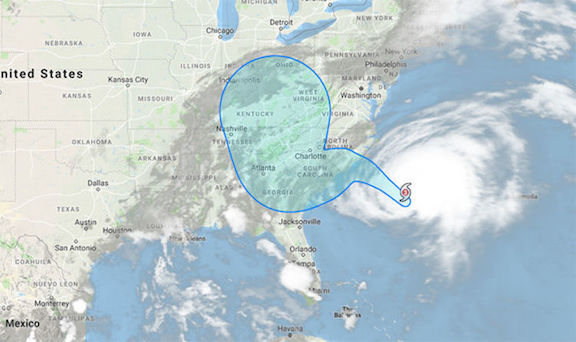Hurricane Florence has arrived, its first rains assaulting North Carolina’s Outer Banks early Thursday.
Weakened to a Category 2 storm, Florence continued to lumber toward the East Coast, still threatening to deliver a deadly 13-foot (4-meter) ocean surge and flooding rains that will drench the region. It shifted its path overnight and is now aiming its fury at Wilmington, North Carolina. Landfall, when the eye meets the shore, is expected on Friday.

The storm still carries 105 mile-per-hour winds, strong enough to tear off roofs and topple trees. It will head across South Carolina Saturday, and up through the Appalachians next week. Florence could eventually cost $10 billion to $20 billion. More than 1,000 U.S. flights have been canceled, and Duke Energy Corp. said as many as 3 million customers may lose power.
“We’re still going to get catastrophic inland flooding from heavy rains and multi-billion dollar storm surge damage along the coast where it hits,’’ said Jeff Masters, co-founder of Weather Underground in An Arbor, Michigan.
Duke has already begun shutting down its Brunswick nuclear power plant, which has two reactors directly in the path of the storm on the southern coast of North Carolina, according to the Nuclear Regulatory Commission. Federal officials have said at least nine nuclear facilities are threatened by Florence.
“It doesn’t look like it will be a major hurricane,” said Anthony Chipriano, a meteorologist with Radiant Solutions in Gaithersburg, Maryland. “But despite that it doesn’t take away from the fact it is a very large and very dangerous system. The storm surge will be significant and the rainfall amounts won’t go away despite the winds not being as strong.”
Florence is about to cross the warm Gulf Stream current, which could see it gather some strength back before it makes the final run at the coast, according to the National Hurricane Center.
The storm’s center is still 145 miles from the coast. As much as 40 inches of rain is predicted for some areas near the coast, with 24 inches expected deeper inland.
A main concern for the region is agriculture. North Carolina ranks second among U.S. states in hog inventory and second in producing broiler chickens. CoBank ACB, an agricultural lender, estimates damage to North Carolina farming could hit $1 billion before the storm slows later this week.
Along with agriculture, the Carolinas stand as an important regional hub for banking, technology, manufacturing and transportation, accounting for about 4 percent of U.S. gross domestic product, according to a Bloomberg U.S. economic analysis. The path may affect more than 4,000 manufacturing and distribution facilities, potentially hurting sectors including auto-parts and packaged foods, according to Bloomberg Supply Chain data.
Several East Coast ports are already seeing disruptions, including Wilmington, Charleston, South Carolina, and Norfolk in Virginia. The three ports together handled 23 percent of imports into the East Coast in 2017.
Combined with disruptions in rail traffic, that could mean serious delays for manufacturers in the region, some of which have already been shut down as a result of mandatory evacuation notices. The Boeing Co., for instance, closed commercial operations at its 787 Dreamliner assembly and delivery plant in North Charleston, South Carolina, on Sept. 11.
Five major hurricanes, with winds of 111 miles-per-hour or more, have come ashore in North Carolina, Phil Klotzbach, hurricane researcher at Colorado State University said in a tweet. The last was Fran in 1996, which hit as a Category 3, according to National Hurricane Center records.










